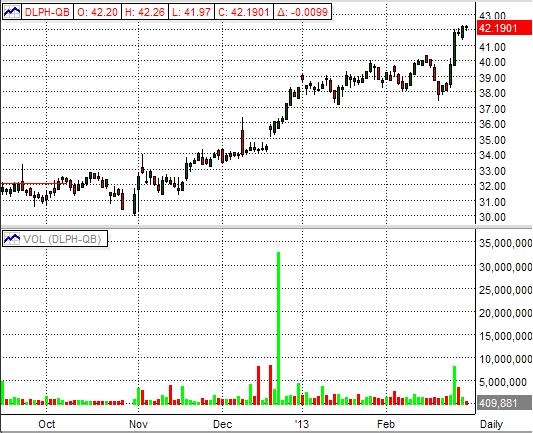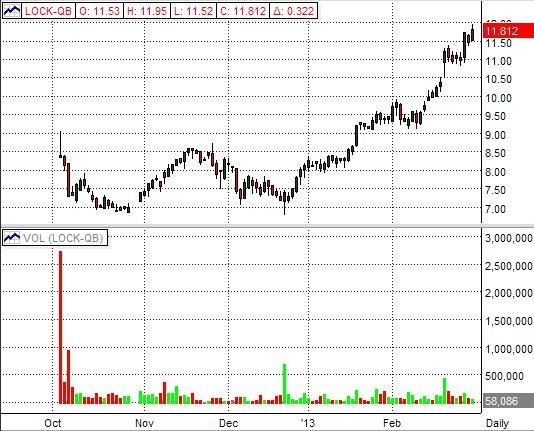All has been quiet on the IPO front lately, but there are a couple recent deals that have been making some noise.
One of these companies executed a turnaround that is as impressive and dramatic than any other in recent history, while the other has been proving skeptics wrong to become one of the more surprising IPO winners over the past year.
Restructuring Actions, Fewer Product Lines, & Solid Execution Now Paying Dividends (Literally) for Delph Automotive (DLPH)
DLPH is a name that is probably familiar to most, given its well-documented history as a GM auto part supplier. But, the company has come a long way from its GM days. Soon after its IPO, DLPH bought back its stake from GM, cutting ties with the then-troubled auto maker.
It’s not only the severed ties to GM, however, that has turned the tables for DLPH. For instance, DLPH has tightened its product focus to concentrate solely on what it calls the “mega trends” in the auto industry: “safety”, “connected”, and “green.” Over the past few years, it has significantly cut its product lines to around 33 from 119, consequently boosting its margins and cutting expenses.
Additionally, DLPH has recognized that its high exposure to Europe and under-exposure to emerging markets has been a major roadblock. Therefore, it has gradually migrated into new emerging markets (namely, China). Not only is this transition helping on the demand side, but, it is also making a huge impact on the bottom line due to the lower labor costs in these geographies.
DLPH’s solid execution has rewarded both the company and its shareholders. In 2012, its credit was upgraded to a rating just below investment grade, and on February 26 it announced its first quarterly dividend since its IPO.
DLPH’s Resiliency Apparent in Recent Financials
On the surface, DLPH’s fourth quarter results aren’t much to get excited about as EPS was essentially flat year/year at $0.90 and revenue dipped 3% year/year to $3.77 billion. But, given its high exposure to Europe, it is a testament to its strategy and execution that its business held relatively firm.
It actually topped analysts’ EPS estimates by $0.08, boosted by its restructuring efforts and notable strength in its Asia markets. Additionally, its full year performance looks much better as EPS and cash flow from operations grew by 38% and 7%, respectively, despite the fact that revenue fell by 3%.
The Key Takeaway
Perhaps a good way to describe DLPH is that it offers something for every type of investor. EPS is growing by solid double-digit rates and value-oriented investors will like its sub-10x forward P/E ratio. The introduction of a new quarterly dividend will put the name on the radar of income-focused investors.

LifeLock (LOCK) Getting the Last Laugh?
One of the more surprising recent IPOs, in terms of its strong, performance, has been LifeLock (LOCK), the provider of identity protection services. It did not exactly come charging out of the gate when it priced below expectations on October 3, 2012 and then promptly sold off sharply in the open market. But, since late 2012, LOCK has been on a tear. Looking back, there was plenty of skepticism surrounding this deal, but with the company putting together back-to-back impressive quarterly reports, it has proved many critics wrong.
Quarterly Results Have Been Impressive
On February 20, LOCK reported its fourth quarter results with EPS coming in at $0.10, beating consensus by $0.03, and revenue jumping by 49% year/year to $78.8 million, easily ahead of the $73.4 million consensus. This strong topline performance followed sales growth of 44% in both 3Q12 and 2Q12.
There are a few catalysts contributing to its success. The company is rapidly adding new members — 198,000 more in the fourth quarter — and its ARPU continues to trend higher. In the fourth quarter, ARPU was up 12% year/year to $9.68. This is driven by an increasing amount of members starting with LOCK’s “Ultimate” solution, its premium product.
Lastly, LOCK’s enterprise business has picked up steam and is now making a more meaningful contribution. Revenue in this segment was $8.0 million in the quarter, representing about 10% of the total.

The Bottom Line
It wasn’t difficult to find LOCK skeptics back when the company went public. Its checkered past included a highly publicized PR disaster when the FTC fined the company in March 2010 for deceptive advertising practices. But, to its credit, LOCK has done a very good job restoring its reputation and communicating how its services are superior to competitors.
The company does have a lot going for it. Identity theft is a growing concern and LOCK has plenty of brand awareness. The addressable market is huge and it still has a lot of runway ahead of it. And, even though the stock has been on fire lately, it isn’t overly expensive, especially when considering its margins are improving, revenue growth has escalated, and it has over $134 million in cash on the books and no debt.




